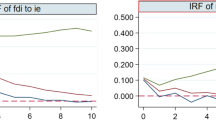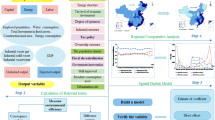Abstract
Persisting in opening up and achieving coordinated development of economy, society, and ecology is China’s major strategies for achieving sustainable urbanization. Ecological efficiency is a reasonable indicator to measure the development level of a circular economy. Therefore, using the statistical data of 30 provinces in China from 2004 to 2016, this paper uses the super-efficiency SBM model that considers undesired output to measure the eco-efficiency value, which is used to measure the level of circular economy development in each province. Based on this, a panel model is constructed to test the impact of circular economy and FDI on urbanization. The empirical results show that (1) there is a complex nonlinear relationship between the development of circular economy and the advancement of urbanization, and the shape of the curve varies with areas; (2) FDI under environmental regulation is conducive to promoting China’s urbanization to achieve green, effective, and sustainable development; and (3) the development of the tertiary industry, human resources, innovation capabilities, and employment situation is conducive to promoting China’s urbanization. Finally, based on the empirical results, this paper puts forward policy recommendations to achieve green, efficient, and intelligent development of Chinese cities by promoting the development of a circular economy and strengthening FDI screening.



Similar content being viewed by others
Data availability
The datasets used and/or analyzed during the current study are available from the corresponding author on reasonable request.
References
Antweiler W, Copeland BR, Taylor MS (2001) Is free trade good for the environment? Am Econ Rev (4):877–908
Chen HM (2018) Foreign trade, foreign direct investment and urbanization—analysis based on the spatial panel dubin method. J Int Trade 10:147–161
Cheng JH, Sun Q, Guo MJ, Xu WX (2014) Research on regional differences and dynamic evolution of eco-efficiency in China. China Popul Resour Environ 24(1):47–54
Clark D (1998) Interdependent urbanization in an urban world: an historical overview. Geogr J 164(1):85
Daniel BL, Korhan KG, Nigar T, José María CC (2019) An approach to the pollution haven and pollution halo hypotheses in MINT countries. Environ Sci Pollut Res 26:23010–23026
Du YY, Sun TS, Peng J, Fang K, Liu YX, Yang Y, Wang YL (2018) Direct and spillover effects of urbanization on PM2.5 concentrations in China's top three urban agglomerations. J Clean Prod 190(7):72–83
Duncan B, Vernon H (1999) The theory of urban growth. J Polit Econ 107(2):252–284
Guo HY, Han LY (2008) Foreign direct investment, environmental regulation and environmental pollution. J Int Trade 8:111–118
Hare D (1999) “Push” versus “pull” factors in migration outflows and returns: determinants of migration status and spell duration among China’s rural population. J Dev Stud 35(3):45–72
Jian XH, Huang K (2010) Empirical analysis and prospect forecast of China’s urbanization level and speed. Econ Res 3:28–39
Jin B (2015) Research on the new normal of China’s economic development. China Ind Econ 1:5–18
Li JK, Cheng LY, Zhang TB (2017) Does foreign direct investment have a “polluting halo” effect? China Popul Resour Environ 27(10):74–83
Liu RM, Shi L (2015) The ownership basis of China’s urbanization delay: theory and empirical evidence. Econ Res 4:107–121
Ma XX (2014) Analysis of the key influencing factors and effects of China’s urbanization. China Popul Resour Environ 24(12):117–124
OECD (1998) Eco-efficiency Pairs, pp7–11
Rafael EP, Wei L, Tridib B (2003) Agencies of globalization and third world urban form: a review. J Plan Lit 18:111–130
Ren M, Wang XM, Liu ZM, Liu L, Zhang WX (2019) Analysis of spatio-temporal changes and influencing factors of regional eco-efficiency in China. East China Econ Manag 33(9):71–79
Schaltegger S, Sturm A (1990) Ӧkologische rationalitӓt: ansatzpunktezur ausgestaltung von ӧkologieorientierten management instrumentent. Die unternehmung 44(4): 273–290
Shi BB, Feng C, Kang R (2019) Environmental information disclosure and optimization of foreign direct investment structure. China Ind Econ 4:98–116
Wang LY, Yang F (2014) Innovation-driven development strategy and China’s future urbanization. China Popul Resour Environ 24(9):163–169
Wen ZL, Zhang L, Hou JT, Liu HY (2004) Intermediary effect test procedure and its application. Acta Psychol Sin 5:614–620
Xing ZC, Wang JG, Zhang J (2018) Research on China’s regional total factor eco-efficiency and its influencing factors. China Popul Resour Environ 28(7):119–126
Xu HL, Deng YP (2012) Has foreign direct investment caused the country’s environmental pollution?—spatial measurement research based on China’s provincial panel data. Manag World 2:30–43
Xu HF, Wang XD (2020) Does modern service industry help promote urbanization?—analysis of PVAR model based on the perspective of industry-city integration. Chin J. Manag Sci 28(4):195–206
Yang L, Zhang X (2018) Assessing regional eco-efficiency from the perspective of resource, environmental and economic performance in China: a bootstrapping approach in global data envelopment analysis. J Clean Prod 173(1):100–111
Ye WH, Gan H (2009) Current status and prospects of circular economy research. China Popul Resour Environ 19(3):102–106
Zhao PJ, Zhang MZ (2018) The impact of urbanisation on energy consumption: a 30-year review in China. Urban Clim 24(6):940–953
Zhu DJ, Qiu SF (2006) Ecological efficiency is a suitable measure of circular economy. China Popul Resour Environ 16(5):1–6
Acknowledgments
We also would like to thank the anonymous referees for their helpful suggestions and corrections on the earlier draft of our paper, upon which we have improved the content.
Funding
This study is funded by the Natural Science Foundation of China (71804182, 71774158), Jiangsu Social Science Fund (18JD013), and Jiangsu Social Science Outstanding Youth Fund.
Author information
Authors and Affiliations
Contributions
Qiaoyu Wang: writing—original draft. Ming Zhang: methodology. Wenwen Wang: formal analysis.
Corresponding author
Ethics declarations
Competing interests
The authors declare that they have no competing interests.
Ethics approval and consent to participate
Not applicable.
Consent for publication
Not applicable.
Additional information
Responsible Editor: Eyup Dogan
Publisher’s note
Springer Nature remains neutral with regard to jurisdictional claims in published maps and institutional affiliations.
Rights and permissions
About this article
Cite this article
Wang, Q., Zhang, M. & Wang, W. Analysis of the impact of foreign direct investment on urbanization in China from the perspective of “circular economy”. Environ Sci Pollut Res 28, 22380–22391 (2021). https://doi.org/10.1007/s11356-020-12321-7
Received:
Accepted:
Published:
Issue Date:
DOI: https://doi.org/10.1007/s11356-020-12321-7




